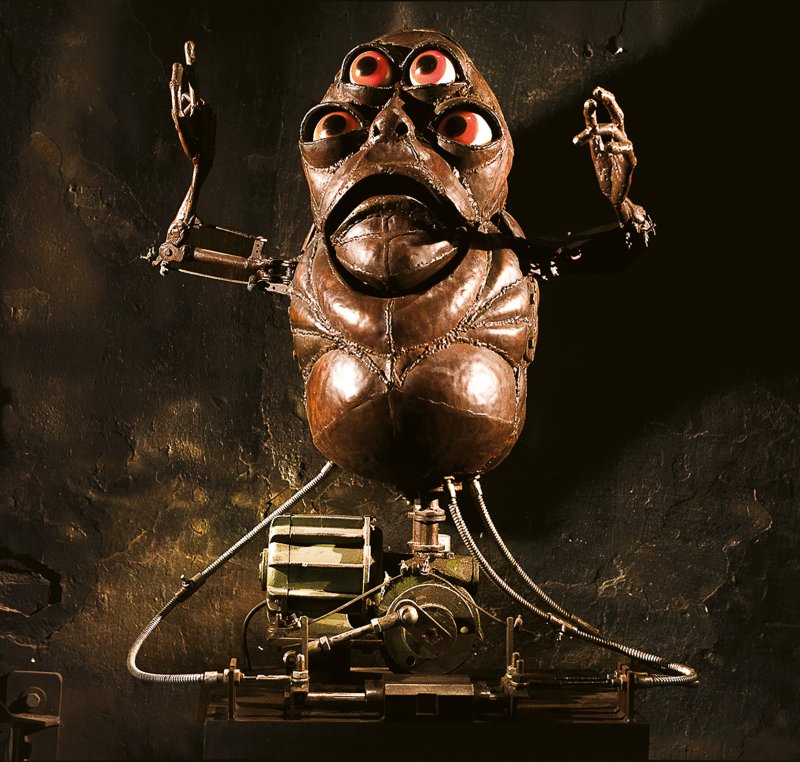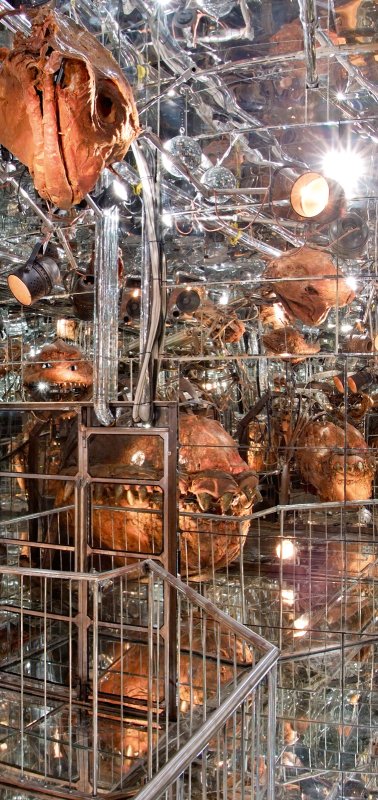„When the living becomes mechanical and vice versa, the effect is simultaneously comical and frightening. The monster machines found in the Monsterkabinett serve as metaphors and surfaces for projection of the fears and the inner conflict of the human mind. These me- chanical beings attempt to dispel and over- come these internal struggles. They possess the liberating effect of a catharsis.“
JoHannes Heiner, Dead Chickens & Artistic Director Monsterkabinett
Parallel worlds are commonly based on a confrontation with the unknown. However, if one embarks on a journey through space and time, where the starting point is a poetic and profound machine theatre, the unknown is substituted by the ‘soul world’– that is, the inner being of the beholder. Upon arrival at this starting point, one finds that the doors to the eerie and mysterious have long been open, for a somnambulistic journey through the Monsterkabinett.
The Monsterkabinett creates a parallel world by way of a walk-through sensory installation experience, in which kinetic automaton sculptures are musically and dramaturgically staged, leading to an artistic journey through space and time. Located in the basement of Haus Schwarzenberg, one of the last remaining centres of in- dependent art and culture in Berlin-Mitte, the Monster- kabinett uncovers traces of cultural history. It is a creation of the Dead Chickens, a collective founded in the 1980s who are pioneers in the field of machine theatre and whose works are sometimes seen as a reflection of the authentic creativity and activity in post-reunification Berlin. But far beyond such categorisation, it is precisely the timeless mechanical art and inventive craftsmanship that characterises the work of the Dead Chickens and so im- presses the viewer with its topicality on several fronts: Firstly, in the Monsterkabinett, various pieces of work in the group’s history are transferred into the here and now. The basic building block of the cabinet is a collection of kinetic sculptures and “monster automatons” from the mobile Dead Chickens exhibition “ChiMech – An Odyssey of Mechanical Creatures”, created for the Ramblas project of the European Capital of Culture Lille 2004. As well as a monster caravan, the exhibition included a Jacquemart, and a computer-controlled electro-pneumatic game clock, which, amongst other creatures, can be found in the Monsterkabinett.
Secondly, the Monsterkabinett presents artistic work, constantly incorporating new techniques and media into the production. The “run-down amusement park,” as the Monsterkabinett affectionately calls itself, operates against the backdrop of animatronics, such as those used in theme parks or the film industry. And so, the visitors become part of an amusement park of a special kind. The bizarre yet charming monsters sing, dance, and write poetry. Not only do they evoke contradictory feelings of affection, fright and fascination, but they also conjure up the surreal scenery of a poetic fantasy film or the immersive virtual reality of a computer game. They in- spire the viewer to engage with the dynamics of a culture and society that is heavily influenced by the media. If the mechanical monsters are metaphors and surfaces for the projection of human fears and inner conflict, then viewers encounter their own inner selves in an equally poetic and pervasive setting of ubiquitous media culture.
Lastly, one of the many strengths of the Dead Chickens lies in their ability to integrate current events into their work. The history and the origins of the Monsterkabinett are certainly a significant component of the show, but at the same time its artistic production is anchored in current affairs and adapts itself to modernity accordingly. In this sense, the monsters are an expression of both cultural-historical and artistic development processes that operate within the Zeitgeist. Thus, they are themselves a manifestation of artistic inner worlds.
The somnambulistic journey through the Monsterkabinett leads the audience through a spatio-temporal masterwork of the Dead Chickens. The artistic, material and psychic worlds exist in parallel, leading back to the inner being: The monsters confront their own inner turmoil with ambivalence. A combination of affection and fright evokes liberating laughter, and with it the redeeming effect of catharsis. The viewers themselves become vo- yeurs, caught between their own inner world and that of the artist. But before the “soul choir” of the Monsterkabinett begins to sing its finale, words accompany the echo of this liberating laughter: “Enter the soul mirror world, perhaps you will encounter yourself?”
Text Vera Fischer








